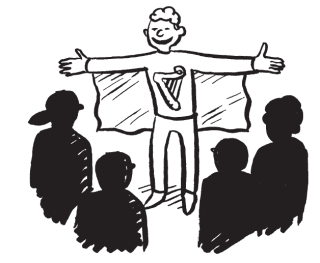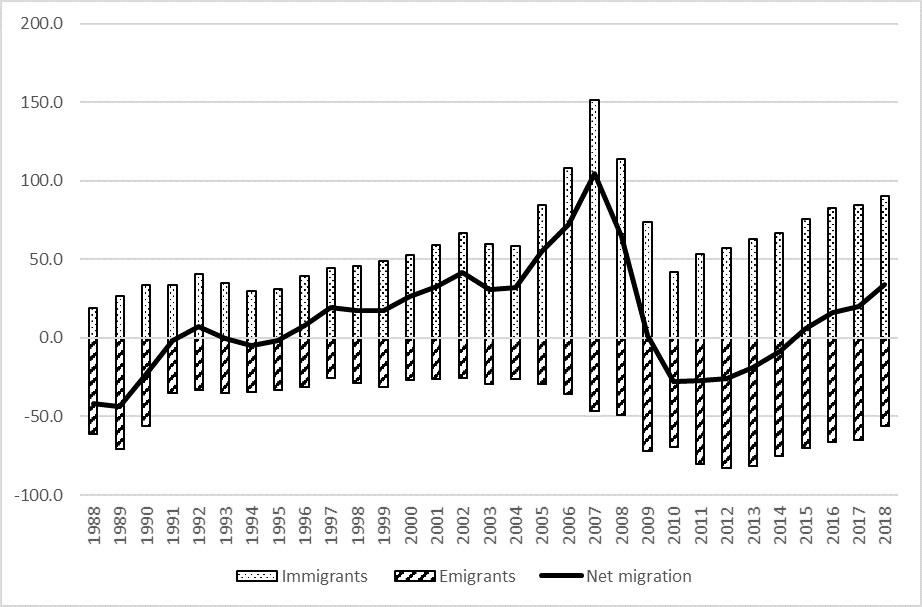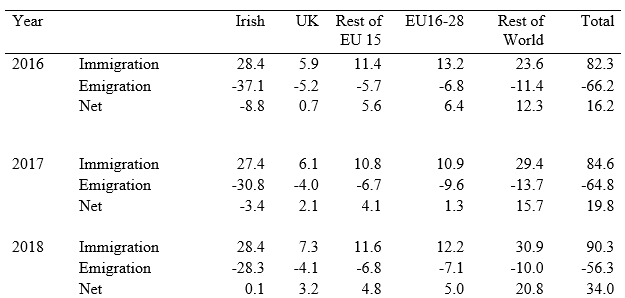Embracing Ireland as a multicultural society

Net migration into Ireland was positive in April 2018, continuing a pattern which has been in place since 2015. This means that more people have entered the country than are leaving it. Analysing migration trends over the past 30 years, we see a relatively high rate of emigration in 1988 and 1989, at a time of recession, which decreased slowly over the next 10 years. In the 2000s, emigration patterns were a little more erratic prior to the recession in 2008, which saw an increase from 49,200 in 2008 to 72,000 the following year (Chart1). Immigration to Ireland peaked in 2007, where 151,100 people came into the country, 37,600 more than the following year.
Chart 1 : Immigration, Emigration and Net Migration, ,000 people, 1988-2018
Source: CSO, Population and Migration Estimates Table 1, 2018. Note: Figures for 2016 taken from Census 2016; Figures for 2017 and 2018 are preliminary
According to the CSO, emigration of Irish nationals continues to fall, decreasing from 49,700 in 2012, to 42,500 in 2015 and an estimated 28,300 in 2018. While there was a slight decrease in Irish nationals returning in 2017, 2018 saw a return to 2016 levels of immigration with 28,400 Irish emigrants returning. Decreasing emigration and increasing immigration indicates a renewed confidence in Ireland’s economic prospects. However, issues with housing and the sustainability of decent jobs, among others, call this fledgling confidence into question.
In terms of origin, 26 per cent of total immigrants to Ireland in 2018 came from the EU (excluding Ireland and the UK), 8 per cent came from the UK and 34 per cent from the rest of the world. According to the CSO, when the destination for emigrants is considered, 25 per cent went to the EU (excluding Ireland and the UK), 7 per cent to the UK and 18 per cent to the rest of the world (Table 1).
Table 1: Estimated Migration by Nationality, 2016 – 18, by ’000

Source: CSO (2018), Population and Migration Estimates. Notes: Data relates to the year to April. ‘Rest of EU’ refers to Pre 2004 EU members less UK and Ireland. ‘EU16-28’ refers to EU Members that joined after 2004.
The numbers of migrants with a third level education continued to rise in 2018. Of those immigrating to Ireland, both the number (from 28,200 in 2012 to 49,200 in 2018) and proportion (56 per cent in 2012 to 62 per cent of all immigrants in 2018) with a third level education has increased. Migrants tend to be younger than the general population with half of both immigrants and emigrants aged between 25 and 44. People aged over 65 were the least likely to migrate.
Although the number of emigrants with a third level education has been in decline since 2012, the proportion of all emigrants with a third level education has increased, from 47 per cent in 2012 to 53 per cent in 2018. Fifty-six per cent of those who left Ireland were employed and a further 19 per cent were students. The proportion of emigrants who are unemployed has also declined since 2012, falling from 22.5 per cent to 13 per cent, reflecting the decrease in unemployment in the country over that period.
In light of higher educational attainment levels of immigrants into Ireland, and the increasing number of Irish people returning to this country, there is a need for a skills transfer programme for returning migrants in order to ensure the skills that they have acquired whilst working abroad are recognised in Ireland. This is something that Social Justice Ireland has advocated for previously. Given the investment made in the education of young graduates, it is essential that steps are taken to retain them and their expertise within Ireland, and to attract back those who have emigrated in recent years. Of course, this is coupled with the need to provide both decent work and infrastructure to support increasing numbers of immigrants who will need to be housed and whose healthcare and childcare needs must be accommodated.
For many migrants immigration is not temporary. They will remain in Ireland and make it their home. In turn, Irish people are experiencing life in different cultural contexts around the world. Ireland is now a multi-racial and multi-cultural country and Government policies should promote and encourage the development of an inclusive and integrated society with respect for and recognition of diverse cultures. The internationalisation of the population presents Ireland with the key challenge of developing a truly integrated society that values cultural and ethnic diversity. The Department of Justice and Equality defines integration as the ‘ability to participate to the extent that a person needs and wishes in all of the major components of society without having to relinquish his or her own cultural identity’. With the rise in populism internationally, we must preserve this position across policies to fully embrace the opportunities inherent in a truly multi-cultural society.